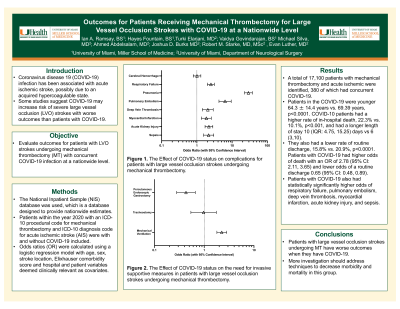Outcomes for Patients Receiving Mechanical Thrombectomy for Large Vessel Occlusion Strokes with COVID-19 at a Nationwide Level
Friday, April 21, 2023


Ian A. Ramsay, BS
Medical Student
University of Miami Miller School of Medicine
Miami, Florida, United States
ePoster Presenter(s)
Introduction: Coronavirus disease 19 (COVID-19) is associated with acute ischemic stroke, possibly due to an acquired hypercoagulable state. Studies suggest COVID-19 may increase the risk of large vessel occlusion (LVO) strokes with worse outcomes than patients without COVID-19. In our study, we investigate outcomes for patients with LVO strokes undergoing mechanical thrombectomy (MT) with concurrent COVID-19 infection.
Methods: The National Inpatient Sample (NIS) database was used, which is designed to provide nationwide estimates. Patients within the year 2020 with an ICD-10 procedural code for mechanical thrombectomy and ICD-10 diagnosis code for acute ischemic stroke (AIS) were included with and without COVID-19. Odds ratios (OR) were calculated using a logistic regression model with age, sex, stroke location, Elixhauser comorbidity score, and patient variables deemed clinically relevant as covariates.
Results: A total of 17,100 patients undergoing mechanical thrombectomy for acute ischemic were identified, 380 of which had concurrent COVID-19. Patients in the COVID-19 group were younger, 64.3 ±14.4 years vs. 69.4 ±14.5 years, p< 0.0001. COVID-10 patients had a higher rate of in-hospital death, 22.3% vs. 10.1%, p< 0.0001, and had a longer median length of stay of 10 (IQR: 4.75, 15.25) days vs. 6 (3,10) days, p=0.0003. They also had a lower rate of routine discharge, 15.8% vs. 20.9%, p< 0.0001. Patients with COVID-19 had higher odds of death with an odds ratio (OR) of 2.78 (95% CI: 2.11, 3.65) and lower odds of a routine discharge with an OR of 0.65 (95% CI: 0.48, 0.89). Patients with COVID-19 also had statistically significantly higher odds of respiratory failure, pneumonia, pulmonary embolism, deep vein thrombosis, myocardial infarction, acute kidney injury, and sepsis.
Conclusion : Patients with LVO strokes undergoing MT have worse outcomes with concurrent COVID-19. More investigation should address techniques to decrease morbidity and mortality in this group.
Methods: The National Inpatient Sample (NIS) database was used, which is designed to provide nationwide estimates. Patients within the year 2020 with an ICD-10 procedural code for mechanical thrombectomy and ICD-10 diagnosis code for acute ischemic stroke (AIS) were included with and without COVID-19. Odds ratios (OR) were calculated using a logistic regression model with age, sex, stroke location, Elixhauser comorbidity score, and patient variables deemed clinically relevant as covariates.
Results: A total of 17,100 patients undergoing mechanical thrombectomy for acute ischemic were identified, 380 of which had concurrent COVID-19. Patients in the COVID-19 group were younger, 64.3 ±14.4 years vs. 69.4 ±14.5 years, p< 0.0001. COVID-10 patients had a higher rate of in-hospital death, 22.3% vs. 10.1%, p< 0.0001, and had a longer median length of stay of 10 (IQR: 4.75, 15.25) days vs. 6 (3,10) days, p=0.0003. They also had a lower rate of routine discharge, 15.8% vs. 20.9%, p< 0.0001. Patients with COVID-19 had higher odds of death with an odds ratio (OR) of 2.78 (95% CI: 2.11, 3.65) and lower odds of a routine discharge with an OR of 0.65 (95% CI: 0.48, 0.89). Patients with COVID-19 also had statistically significantly higher odds of respiratory failure, pneumonia, pulmonary embolism, deep vein thrombosis, myocardial infarction, acute kidney injury, and sepsis.
Conclusion : Patients with LVO strokes undergoing MT have worse outcomes with concurrent COVID-19. More investigation should address techniques to decrease morbidity and mortality in this group.
